The Power Couples guide to buying the best engagement ring.
Ultimately, most power couples are looking for a quality experience, a craftsman whose attention to detail is meticulous, and a ring that is truly one-of-a-kind.
At this level, you’re either looking to go with an independent jeweller, someone who’s devoted their entire working life to jewellery, or a specialty retailer like Tiffany & Co or Van Cleef and Arpels. To be straight with you, if your lover is already devoted to a brand’s style, then just go with what she wants! But if she has a ring setting in mind, or you want to surprise her with something special, then you may find this guide we created very helpful. It covers all your options, and if you’re interested, what to look for in buying diamonds.
We did this so power couples can make an informed and intelligent decision, so they can get top quality in a timely manner.
You can read it here or you can leave your name and email so I can personally send you a PDF copy (that way you don’t have to delete your search history later). That’s all you’ll receive by the way. No sales pitch or anything of that sort.
Go ahead, read on or type in your name and email, and give me the pleasure of knowing my experience was put to good use.
Your friend at the bench,
Seth Tobin
Master Craftsman & Director of happy power couples at Seth Tobin Jewellers
Contents
Find out what she wants first.
Biggest headstart you can get in choosing a ring is figuring out the style she loves. Also keep in mind humans are social creatures. If the husband’s you hang out with all bought their woman $20,000.00 rings, how will your woman feel about hers?
Get clear on your expectations.
What are her expectations? Is the ring just a “symbol”? Does she want a particular brand or is she just looking for something big and bold? These things should be found out. If you’re stumped on how to do this, don’t worry, later I’ll show you ways to ask her questions that have worked for other power couples.
Ok so how do you find out about the style of the ring? Simple. By asking. Feel free to use this word-for-word script:
“I love you and I’m excited about our future together. I know we’ve talked about marriage, and there’s something else I want to be open with you about: the ring. Maybe you’ve thought about it as well, because I definitely have. What kind of ring do you have in mind? The band? I’d love to know what you think.”
You’ll notice that this question:
- Makes her know we’re in this together (less stress).
- Is friendly and open.
- Doesn’t bring up any concerns about the budget.
Any question is better than no question at all.
Ask your fiancée to send you what she likes.
Have her message you photos, or share a Pinterest board. I’m sure she’s already saved a few Instagram photos as well.

Now that we have the inspirations, it’s time to understand our choices.
Choosing the ring.
What types of metals are available for the band?
Most power couples will go with gold – either white, yellow or rose and there’s also silver and platinum.
What type of ring settings are there?
In short, several. Here are a few.

Ring proportions.
You may want to think about ring proportions and the size of your lover’s finger. Some people say that if the finger is slender and long, you’ll want a narrow band with a wide stone to make it look in proportion. The opposite may be true for broad fingers. But it comes down to personal preference.
So what about the 4C’s?
The 4C’s is a good start for selecting diamonds, but it’s not the end-all-be-all that most jewellers make it out to be. If you haven’t heard of 4C’s before, basically you have 4 characteristics that make up the overall value of the diamond – the cut, the clarity, the colour, and the carat weight. Each characteristic has its own scale to go by.
Diamond cut.
The cut is the most important C because it determines how shiny the diamond is. Most people think that the cut is the shape (diamond, oval, heart, solitaire etc) but the cut is all about how well a diamond interacts with light to produce shine and brilliance. This is due to the geometry and the proportions of the diamond. 3 things that are looked for in a diamond cut that give it that shine we all love are the:
- Brightness – how light reflects the diamond.
- Fire – how effectively white light hits the diamond and scatters into all the colours of the rainbow.
- Scintillation – the amount of sparkle a diamond produces, and how well the diamond creates light and dark areas on the inside.
Grades range from Excellent (the best) to poor (the worst), with most jewellers carrying cuts above good or very good.

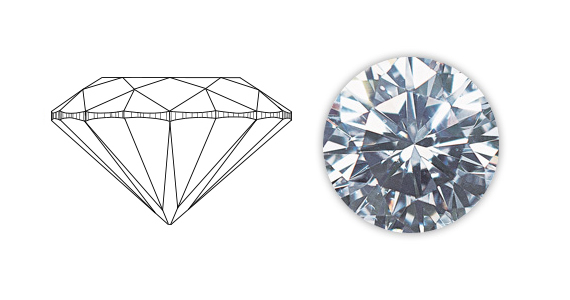
This cut has optimal fire and brilliance because it’s using all of the light to reflect back to your eye.
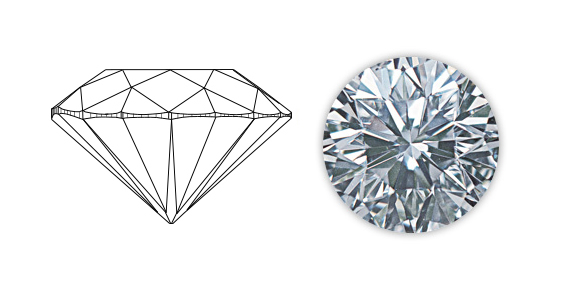
When you look down at a very good cut, you’ll see light and dark spots. But from the sides it will have excellent sparkle.
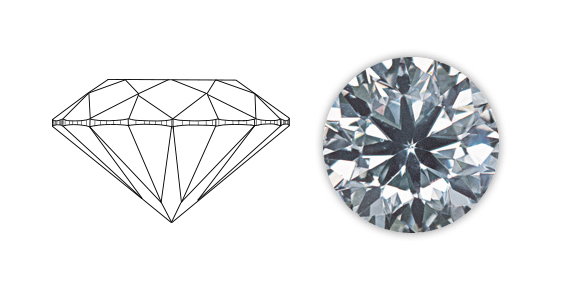
A good cut is well, just good.
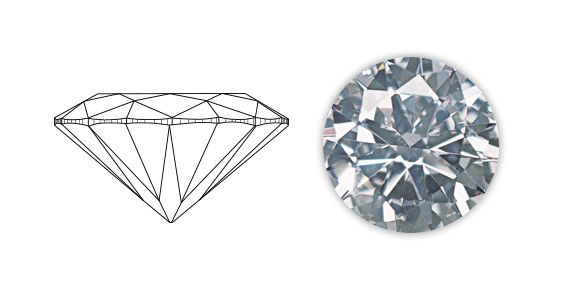
A fair cut won’t reflect light so the sparkle is significantly lower.
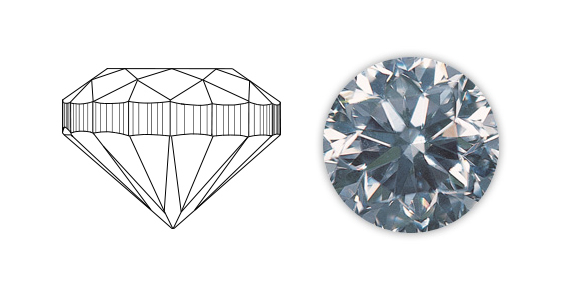
A poor cut is dull to the human eye.
Diamond clarity.

Diamonds are formed deep within the earth, then put under intense heat and pressure. As a result, the diamonds form imperfections called inclusions (inside of the diamond) and blemishes (exterior of the diamond). So when we talk about the clarity, we’re talking about the absence of these birthmarks. There are 11 grades. Most reputable jewellers will not carry anything below SI2.

Flawless (FL).
No blemishes or inclusions are seen under 10X magnification.
Internally flawless (IF).
No inclusions but blemishes are seen under 10X magnification.
Very very slightly included (VVS1 and VVS2).
Inclusions are present but very difficult to see under 10X magnification.
Very slightly included (VS1 and VS2).
Inclusions are present and range from easy to difficult to see under 10X magnification.
Slightly included (SI1 and SI2).
Inclusions are noticeable under 10X magnification.
Included (I1, I2 and I3).
Inclusions are obvious under 10X magnification.
Diamond colour.

The more colour a diamond has the less its value. Most power couples go with something colourless or near colourless to the eye. Most reputable jewellers will not carry anything below J grade.

Diamond carat weight.
For carat weight, of course, the heavier it is, the more its value. There are price per carat increases at 0.50, 0.70, 1.00, 1.50, 2.00 respectively. The prices are less under and between those amounts (for example 0.86 carat). Often when people know this they still want the pedigree of a certain size but sometimes they see value in going slightly less in weight.

A word of caution.
The 4C’s isn’t the end all be all. Most power couples still care mostly about size, shine, and the overall style of ring that your woman wants. But if you’re looking for value, then you need the right scale to determine that value.
Diamond grading reports.
This ensures that you get what you pay for. You should always get a report with your diamond, included in the price. If the jeweller buys a diamond that comes with a certificate, then the client gets the original certificate as it is part of the documentation. The jeweller keeps a record of the serial number for their records and in case the client misplaces their information. With the serial number, all original information can be retrieved. Also the serial number is laser engraved on the diamond so it can be read under magnification. The most common report is the GIA. There are other reputable reports but they’re much less common.
What about protection plans?
A reputable jeweller should not be selling a protection plan on top of the ring. Instead, they should be offering you a lifetime warranty, where you can get one free sizing, unlimited cleanings and inspections, and free repairs for any defects. If there are any wear and tear or abusive damages, the repairs should be done at wholesale cost determined by the jeweller.
So do I go with ready-to-wear or custom?
Ultimately it depends on you. If she’s interested in a style or a particular setting, there are 3 things you should be looking for:
- Look for someone who gives you options for the band and the centre stone, while giving you the pros and cons for each.
- Once the jeweller and you are clear on the vision, he or she should create you a model, either a digital one or 3-D model. The 3-D model is better because you’ll have a clear idea of what you’re getting.
- Make sure your jeweller does absolutely everything in-house. Why? Because the jeweller is the one you shared your vision with. If they give it off to someone else, it’s very possible that the vision will go into a different direction.
So far we’ve covered how to find the ring of your lovers dreams, and how to choose the ring. Now for the final step, we’ll teach you how to buy the ring and what to look for in a jeweller.
Buying the ring
Specialty retail stores
Ultimately, with specialty brands like Cartier and Tiffany’s, you’re paying for the brand. If you look at it from a strictly diamond and metal point of view, you’re paying about double for the name if you were to compare two identical rings. But if she’s set on a brand, then just go for it. It’s the right decision to make in the long run.
Independent jewellers
This is the option to go with if your woman is not committed to a certain brand, and she’s more into the style or setting of the ring.
The biggest thing to look for if you go down this route is that you work directly with the craftsman and not a sales-person. Reason being, the craftsman will know all the nuances of the ring – the rarity of the diamonds, how to take your vision and add to it so your ring becomes even more special. These are the things that take your ring to the next level.
Booking appointments
So if you’re thinking of going with an independent jeweller, the best thing to do is book 3-5 appointments with several jewellers so you can pick the one that best fits you. At the end of the day, the ring is a collaboration between the couple and the jeweller, so you should feel comfortable and excited to share your vision.
How should I approach each jeweller?
Have your vision in mind. A quality jeweller will respect that you want the best and will make sure every detail is covered. The other important thing you should have for your jeweller are the inspiration images or ideas from your significant other. If you send them in before your appointment, your jeweller can get a head start and show you rings that are aligned with your vision.
From the jewellers perspective, all they’re trying to do is figure out where you’re coming from. Do you want unique details on the band, is she particular about the centre stone, does she want to make her ring one of a kind etc etc. Once they figure out where you’re coming from, they can help you out in the best way possible.
So there you have it! You’re all up to speed on purchasing the engagement ring of your lover’s dream. Go out there and wow her.
A word from Seth Tobin Jewellers
If you end up wanting to work with an independent jeweller, I would be thrilled to get the chance to know you and understand your vision. I’ve been making power couples happy with their rings for over a quarter century. Every ring that I create is a story embedded in my mind. I think in rings, metals, and stones. We offer free protection plans for all our clients which includes one free sizing, unlimited cleanings, free repairs and wholesale prices for any serious damages. We’re family owned and operated, with no “sales staff”. If you want to work with a true craftsman than come into the store and introduce yourself. Show us your inspirations and let’s make this the best engagement ring possible.
Your friend,
Seth Tobin
Master Craftsman & Director of happy power couples at Seth Tobin Jewellers
P.S Want an engagement ring checklist? Leave your contact info below and I’ll personally send one over.